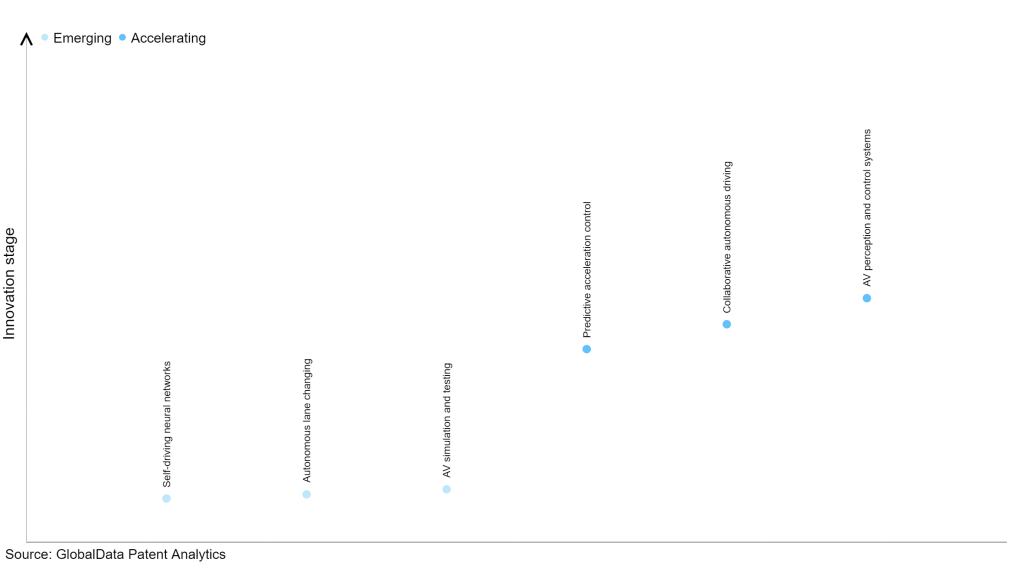The automotive industry continues to be a hotbed of patent innovation. Activity is driven by safety, cost, performance, and convenience, and growing importance of technologies such as 3D object detection, sensor fusion. In the last three years alone, there have been over 720,000 patents filed and granted in the automotive industry, according to GlobalData’s report on Artificial intelligence in automotive: object detection DNNs. Buy the report here.
However, not all innovations are equal and nor do they follow a constant upward trend. Instead, their evolution takes the form of an S-shaped curve that reflects their typical lifecycle from early emergence to accelerating adoption, before finally stabilizing and reaching maturity.
Identifying where a particular innovation is on this journey, especially those that are in the emerging and accelerating stages, is essential for understanding their current level of adoption and the likely future trajectory and impact they will have.
300+ innovations will shape the automotive industry
According to GlobalData’s Technology Foresights, which plots the S-curve for the automotive industry using innovation intensity models built on over one million patents, there are 300+ innovation areas that will shape the future of the industry.
Within the emerging innovation stage, self-driving neural networks, autonomous lane changing and AV simulation and testing are disruptive technologies that are in the early stages of application and should be tracked closely. Predictive acceleration control, collaborative autonomous driving, and AV perception and control systems are some of the accelerating innovation areas, where adoption has been steadily increasing.
Innovation S-curve for artificial intelligence in the automotive industry

Object detection DNNs is a key innovation area in artificial intelligence
Object detection deep neural networks (DNNs) are a type of machine learning algorithm used in computer vision to detect objects within an image or video. These DNNs use a combination of convolutional neural networks (CNNs), which are used for feature extraction, and region proposal networks (RPNs), which propose candidate regions likely to contain an object, to accurately identify objects in complex visual scenes.
GlobalData’s analysis also uncovers the companies at the forefront of each innovation area and assesses the potential reach and impact of their patenting activity across different applications and geographies. According to GlobalData, there are 1265+ companies, spanning technology vendors, established automotive companies, and up-and-coming start-ups engaged in the development and application of object detection DNNs.
Key players in object detection DNNs – a disruptive innovation in the automotive industry
‘Application diversity’ measures the number of applications identified for each patent. It broadly splits companies into either ‘niche’ or ‘diversified’ innovators.
‘Geographic reach’ refers to the number of countries each patent is registered in. It reflects the breadth of geographic application intended, ranging from ‘global’ to ‘local’.
Patent volumes related to object detection DNNs
Source: GlobalData Patent Analytics
Intel is one of the leading patent filers in object detection DNNs for the automotive industry. One of the latest patents Intel has filed is for a system and method for training autonomous vehicles (AVs) to navigate complex environments. The system uses a deep learning algorithm to predict other vehicles' and pedestrians' behavior, and a reinforcement learning algorithm to train the AV to navigate safely and efficiently. The system is designed to be deployed in a simulation, where the AV learns from the simulation to navigate the real world safely. This patent could potentially improve the safety and performance of AVs in real-world conditions. Stradvision and International Business Machines (IBM) are some of the other key patent filers in object detection DNNs.
In terms of application diversity, Fujifilm leads the pack, while Motorola Solutions and STATS stood in the second and third positions, respectively. By means of geographic reach, Nuro held the top position, followed by Shanghai Cambricon Information Technology and Proxy Technologies.
To further understand the key themes and technologies disrupting the automotive industry, access GlobalData’s latest thematic research report on Artificial Intelligence (AI) in Automotive.
Data Insights
From

The gold standard of business intelligence.
Blending expert knowledge with cutting-edge technology, GlobalData’s unrivalled proprietary data will enable you to decode what’s happening in your market. You can make better informed decisions and gain a future-proof advantage over your competitors.



